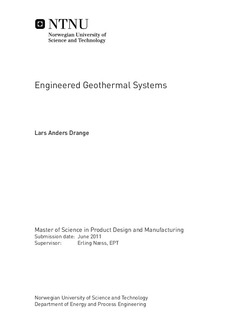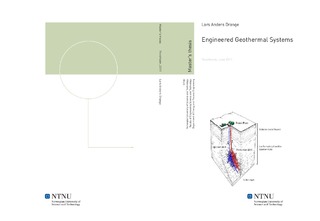| dc.contributor.advisor | Næss, Erling | nb_NO |
| dc.contributor.author | Drange, Lars Anders | nb_NO |
| dc.date.accessioned | 2014-12-19T11:46:51Z | |
| dc.date.available | 2014-12-19T11:46:51Z | |
| dc.date.created | 2011-09-19 | nb_NO |
| dc.date.issued | 2011 | nb_NO |
| dc.identifier | 441758 | nb_NO |
| dc.identifier | ntnudaim:6379 | nb_NO |
| dc.identifier.uri | http://hdl.handle.net/11250/234402 | |
| dc.description.abstract | Different concepts for Enhanced Geothermal Systems (EGS) are presented and evaluated according to their potential for medium to large scale power production in Norwegian conditions. Potential locations for geothermal energy in Norway are identified. A fractured EGS with multiple wells situated in a low to medium temperature granitic basement was found to be the concept best suited for medium to large scale power production in Norway. An Organic Rankine Cycle (ORC) is typically used as the heat conversion cycle in low to medium temperatures. The ORC yields a better thermal performance in these temperatures, compared to flash cycles and Stirling engines. It is also a mature technology and commercially available. Thermal efficiency of the ORC was found to decrease drastically when operated at lower than design temperature. A numerical model of a fractured EGS was developed using Matlab. The model was able to capture the long term thermal behavior of a EGS. Based on this model was a sensitivity analysis conducted in order to see how responsive the thermal output is to different parameters. Typical ranges of fractured EGS parameters was found in existing literature regarding EGS. Thermo physical properties, such as thermal conductivity and specific heat, are highly dependent on mineral composition and temperature. They can therefore vary several factors between sites. Typical fracture apertures were found to be between 0.2 mm to 3 mm, and dependent on local geological conditions. The thermal output from the fractured EGS was found to be highly sensitive to changes in parameters like fracture aperture, fracture length and fracture spacing. Geothermal energy is marginal at best, consequently is it vital to extract as much geothermal energy as possible. A typical fractured EGS is therefore designed with a temperature drop of about $10^0C-15^0C$. The result is that the system is highly sensitive to variations in reservoir parameters. It is therefore critical to obtain accurate estimates and models of the fractured reservoir, and to control the fracture development during stimulation and operation. A system consisting of a fractured EGS and ORC was found to be extremely sensitive to variations in geothermal temperature. A temperature decrease of 10% yielded a 25% decrease in net work output.In order to reduce the risk related to the uncertainty of the geothermal temperature over the life time of the EGS is it advisable to combine geothermal energy with an alternative energy source. A hybridization of geothermal energy and a waste combustion plant was found to yield a stable power output regardless of geothermal temperature, and also offered a higher thermal efficiency than a standalone ORC. Geothermal energy could either by used as pre-heat in the waste combustion cycle or a ORC bottoming cycle could be used. | nb_NO |
| dc.language | eng | nb_NO |
| dc.publisher | Institutt for energi- og prosessteknikk | nb_NO |
| dc.subject | ntnudaim:6379 | no_NO |
| dc.subject | MTPROD produktutvikling og produksjon | no_NO |
| dc.subject | Energi-, prosess- og strømningsteknikk | no_NO |
| dc.title | Engineered Geothermal Systems | nb_NO |
| dc.type | Master thesis | nb_NO |
| dc.source.pagenumber | 202 | nb_NO |
| dc.contributor.department | Norges teknisk-naturvitenskapelige universitet, Fakultet for ingeniørvitenskap og teknologi, Institutt for energi- og prosessteknikk | nb_NO |

